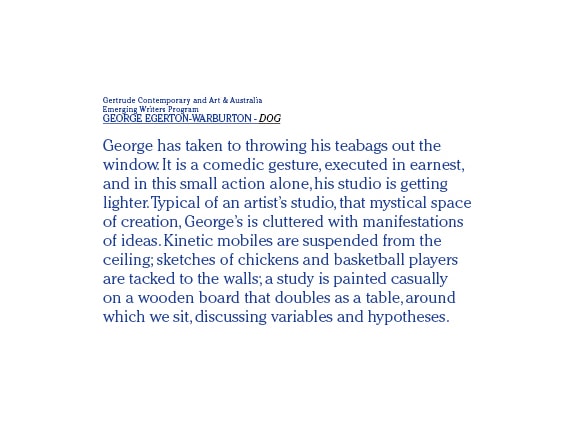programs

EMERGING WRITERS: GEORGE EGERTON-WARBURTON
Download the catalogue here
George has taken to throwing his teabags out the window. It is a comedic gesture, executed in earnest, and in this small action alone, his studio is getting lighter. Typical of an artist’s studio, that mystical space of creation, George’s is cluttered with manifestations of ideas. Kinetic mobiles are suspended from the ceiling; sketches of chickens and basketball players are tacked to the walls; a study is painted casually on a wooden board that doubles as a table, around which we sit, discussing variables and hypotheses.
Taped to the studio wall is a quote from Tiqqun’s Introduction to Civil War: “Each body is affected by its form-of-life as if by a clinamen, a leaning, an attraction, a taste. A body leans toward whatever leans its way. This goes for each and every situation. Inclinations go both ways”. This is true even of those who appear devoid of any inclination. What they are inclined towards instead, is nothingness itself.
In light of this idea, which printed on paper ironically adds to the detritus of the studio, the defenestration of the teabags can be seen as exemplary of George’s own inclination towards nothingness, or rather his desire to create something in the pursuit of nothing. This altering of space through wilful projection has led him to think about other excretions or by-products, including birth, factory emissions and – of course – defecation. On a more immediate, guttural level, he draws comparisons between himself and a caged animal, clearing his habitat of his own waste. The zoo animal and the artist are not so dissimilar. The audience encounters both in an illusory environment where there is a certain vulnerability on behalf of the animal/artist; an expectation to perform, to entertain.
This relationship between art and animals is not an accidental one. The first subject of artistic endeavour was the animal kingdom with their blood used as an early means of mark-making. The menagerie or zoo is another form of a museum, where animals, like artworks, have been collected and categorised. The caged animal’s capacity to return our gaze and inability to communicate through common language ascribes a certain mystery to them. Perhaps the same can be said of an artwork. We examine both in order to understand them.
John Berger has reminded us that when visiting the zoo, “you are looking at something that has been rendered absolutely marginal”. Stripped of their purpose, animals are reduced to objects of curiosity or worship. As an expansion of his exhibition in Studio 12, George is taking his practice out onto the street, literally propelling objects and artwork from his studio to gather in the shared lane beneath his first floor window. Removing work from the exhibition space raises questions of art’s ability to survive outside its institutional context. How does this sculptural pile differ from other trash? And what is the function of the studio now that the art has been removed?
George shows me two sculptural studies: Sisyphean boulders made from plaster and sand. I imagine him on his hands and knees, digging at the beach – the sand dry at first, getting damper the deeper he goes. Here in the gentrifying heart of Fitzroy, in George’s white-walled studio, the sculptures look incongruous, out of place. It is as though a little bit of life has been let in, replacing the art that has been allowed out. George says that he has been thinking about puberty, that reckless, formative and experimental time. But to me, the sculptures undulate like dry, distant hills. They are the formal resolution of a deep conceptual process that both relate to and stand independent from it.
George pulls the Tiqqun quote from his studio wall, handing it to me on my way out. I thought nothing of taking it at the time, but I can’t help thinking now that it was part of his plan. An idea freed unto the world; a studio emptying out.